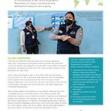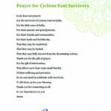
Guidance for Including Conflict Sensitive Questions in Emergency Rapid Assessments
This guide is provided as a reference for country teams or emergency response advisors who are in the process of designing a rapid assessment. As there may not be time for an in-depth conflict analysis, the guidance and questions below are intended to assist country teams in quickly gathering information crucial to ensuring conflict sensitive programming during their rapid assessment.
Conflict sensitivity is defined as:
‘An approach to programming and policymaking that recognizes the potential influence between conflict-affected contexts and a policy, program or project in that region. Conflict-sensitive policies, programs and projects aim to minimize unintentional negative impacts that may drive conflict and cause further social divisions while maximizing positive impacts on the context that mitigate conflict and bridge social divides.’ (Schirch, Conflict Assessment and Peacebuilding Planning; Kumarian, 2013).
Response teams would then be advised to analyze the assessment data to consider factors which could potentially cause or exacerbate tensions in the area of intended implementation. This analysis could be done using a simple connector/divider exercise with staff/partners knowledgeable of the local context.
The sample questions below are only suggestions which can be tailored to the context. As some of these questions could prove sensitive in certain contexts please ensure that local staff have reviewed the questions to determine if appropriate. If these topics cannot safely be asked during a rapid evaluation, they should at least be discussed with an intentionally selected team or staff, partners or other stakeholders.
First Step: Consider the relevant context and important aspects of conflict sensitivity for that context:
Context: Any emergency response in a location with diverse ethnic or religious groups
Guidance: Ensure an interview is held with at least one member of each relevant ethnic group or that separate FGDs are held with diverse ethnic groups. Additionally, keep in mind that marginalized groups may not have equal access to information as they may not have direct communication with local leaders who are often tasked with informing communities about an assessment or FGD. Assessment teams should include members of these various groups.
Sample Questions:
- Do you feel that all groups/communities have comparable access to the resources needed right now?
- If not, who is receiving resources and who is not?
- What resources specifically are not being equitably distributed based on need?
- What are the barriers to all groups/communities receiving these resources?
- What is the best way for you to receive information about the response activities?
- Do you feel that there are any representatives of key groups not currently being consulted on decision making for the emergency response?
Context: Emergency response (conflict based) in a location with violence between antagonist groups such as ethnic or religious groups
Guidance: Ensure that an interview is held with at least one member of each relevant ethnic/ opposition group or that separate FGDs are held if access allows. In such a situation with substantial tensions between diverse groups, extra effort should be made to ensure that assessment teams are composed of ethnically/politically diverse members or that members are from identity groups not associated with the conflict.
Sample Questions:
- Do you feel that your identity/ethnicity/religion has affected your access to goods and services?
- If so, explain which services have been restricted and how your access was impeded.
- Do you have any concerns/advice concerning how aid should be delivered to reduce risk for yourself and your community?
Context: Emergency response (natural disaster or conflict based) which has resulted in clearly defined ‘host’ and ‘displaced’ populations living close to one another
Guidance: Both host and displaced populations should be interviewed or focus groups held with each in order to avoid introducing or exacerbating tensions with the response. The priority needs of both host and displaced populations should be determined during the assessment.
Sample Questions:
- For host community members: Do you have any concerns regarding the presence of displaced populations in your community?
- If so, do you have any suggestions to alleviate these concerns?
- For the displaced population: Do you have any challenges in your relationship with the host community?
- If so, do you have any suggestions to address these challenges?
- For host and displaced populations: What do you see as opportunities to better connect the host community and the displaced through the relief efforts?
Context: Any emergency response (natural disaster or conflict based) where prior to the assessment we know that certain neighboring groups will not be targeted (non-beneficiaries)
Guidance: This situation may exist in a context where the assessment is designed to respond to a certain donor criteria or sector, so beneficiaries can only fit a certain profile. We’d want to be sure to also be aware of the views of non-beneficiaries to ensure that we do not create conflict. Therefore the below questions should be asked to those groups likely to be non-beneficiaries.
Sample Questions (to make sure that we are also asking to groups that we know will likely be non-beneficiaries) :
- What are your major concerns as a result of the (emergency event)?
- How have you been impacted by the (emergency event)?
- Are there resources that are lacking or over-utilized in your community? If so, which ones?
Next: If you are doing a rapid assessment with a focus on a particular sector, consider the relevant risks:
Sector: Emergency assessments specific to WASH needs (particularly in environments with displaced populations)
Guidance: Regarding issues of water sources and sanitation, considering the situation of host or non-beneficiary populations will be crucial to avoiding conflict.
Sample Questions:
- (For hosts or non-beneficiaries) Can you explain any changes you have encountered to your access to water since the (emergency event)?
- (For hosts or non-beneficiaries) Can you explain any changes you have encountered regarding sanitation or waste disposal since the (emergency event)?
- (For displaced or conflict-affected populations) Can you explain any restrictions you have faced in accessing available water points or sanitation infrastructure?
Sector: Emergency assessments specific to Shelter needs (particularly in environments with displaced populations)
Guidance: In order to not create tension between beneficiaries and non-beneficiaries, extra pre-cautions should be take around land use, the availability of natural resources and the quality of materials provided to beneficiaries relative to the quality of materials used by existing residents.
Sample Questions:
- (For hosts or neighboring non-beneficiaries when considering transitional or permanent shelters) What are the typical building materials used in your community? To what extent are these materials currently accessible to you and to others?
- (For hosts or non-beneficiaries) Do you have concerns around the availability of local materials used by the displaced to construct shelters?
- (For hosts or neighboring non-beneficiaries) What types of community infrastructure would your community most benefit from?
- Who in the community would benefit the most from this type of infrastructure?
Sector: Emergency assessments specific to Food Security and Livelihood needs (particularly in environments with displaced populations or a history of violent conflict)
Guidance: Food security and livelihood interventions in an emergency response can be some of the most visible and desirable given the size and value of the inputs provided to meet the most basic and pressing needs. These inputs can place communities at a greater risk and exacerbate tensions.
Sample Questions:
- (For both potential beneficiaries and non-beneficiaries) What do you feel are the safest modalities to meet the food needs in your context?
- (For both potential beneficiaries and non-beneficiaries) Are there restrictions regarding access to land for certain population groups in the surrounding area?
- What types of land resources are available to vulnerable groups (women, IDPs/refugees, returnees, minorities)?
- What are the land restrictions for various groups?
The above guidance has been informed by CRS’s ‘Humanitarian Response in Violent Conflict: A Toolbox of Conflict Sensitive Indicators,’ 2012.




